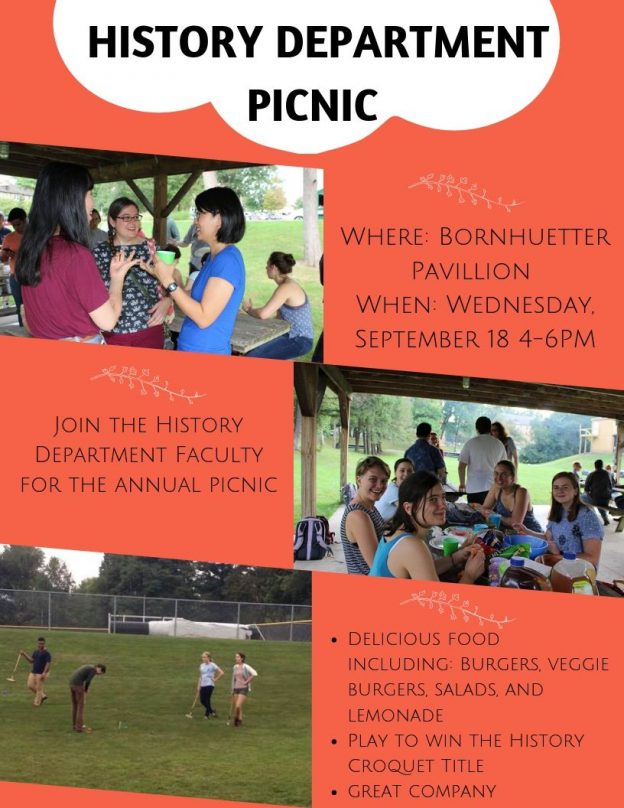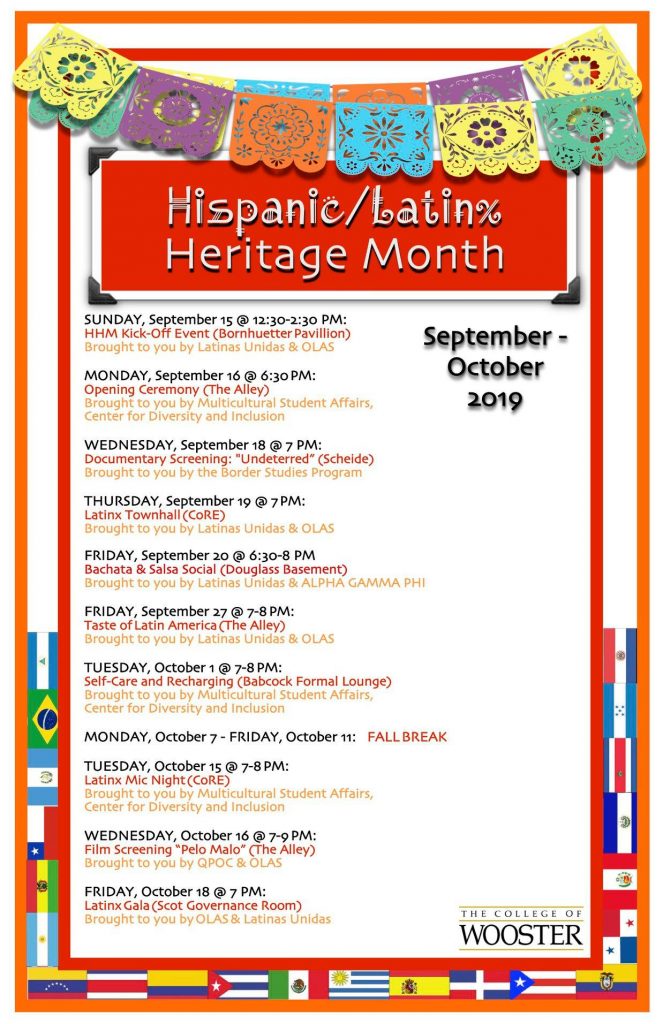




Class Topic: First Reports
Historical Analysis:
Dr. Mariselle Meléndez
Writing Strategies:
Christopher Columbus’
German Views of Iberian Dress: Christoph Weiditz (1529)


For the full schedule, see the Center for Diversity and Inclusion: @CDIatCOW
All are welcome at our fall picnic! I write to share a message from our official picnic historian, Dr. Greg Shaya:
Please join us for the Fall History Picnic Wednesday 9/18 from 4-6pm at Bornhuetter Pavilion!
Come relax together and meet your professors and fellow students. Your student reps and your favorite professors will be there.
We’ll supply hamburgers, veggie burgers, salads and lemonade. There will be croquet – and the distant possibility that a student may win the title. (It would be the first time, however. A Shaya family member has held the History Croquet Title since the founding of the game.) For more information on croquet at Wooster, see https://youtu.be/oFMCUzsKHrs
We hope to see you all there! gks
Overall, the class discussion of the day was focused on Brazil and the Caribbean. This included particular analysis and discussion of 3 primary groups. These groups are the Taino and the Arawack, which are from the Caribbean, and the Tupi, who are native to Brazil. The class focused on two essential questions: 1) How did the natural environment shape the lifestyles of peoples in these areas? And 2) What evidence is available for historical research into Brazil and the Caribbean? We started the discussion with the topic of semi-sedentary lifestyle of the native peoples of Brazil and the Caribbean. They combined hunting and gathering with agriculture which before now was rarely done as hunting and gathering requires movement whereas agriculture usually requires staying in a set place to allow crops to grow. This was a unique way in which the peoples adapted to their environment. We then discussed the population trends of Indigenous Peoples of Brazil. Some students were intrigued by the fact that over time, Indigenous People have gone from composing 100% of Brazils population to less then 1%. It also interested students that there was a drastic decrease of population for coastal indigenous populations whereas indigenous populations in the middle or main area of the country sustained similar population levels for an extended period. Professor Holt made a side note about the current issues in Brazil with disrespect towards Indigenous peoples by the President of Brazil Jair Bolsonaro. He is trying to take away protections of Indigenous peoples as well as allowing for the environment that is their home to be destroyed. The conversation then shifted to agriculture and how it impacts different parts of the world. We discussed where different agriculture is produced and discussed the importance of manioc (def: A tropical plant from which cassava and tapioca are prepared) in Latin America.
We then shifted focus to an audio slideshow by Elisabeth Rosenthal: “An Ancient Society Faces New Change in Brazil.” The slide show discussed the environment of Brazil, the impacts people are having on Xingu National Park, culture and lifestyle, and how culture and lifestyle are in some ways threatened by ways of modern life. After the audio slideshow, we discussed the ways we thought the slideshow was positive or negative in presentation. We said that the way in which the author presented the slideshow through an us versus them tone was ineffective and a poor presentation style. We also thought the style was story book like and acted like anyone watching was a child. The audio slideshow also lacked interviews or reference to solid sources. Some even argued that the way in which the author presented information contradicted with other information the author stated. Next, we heard a student book presentation on “Go Betweens and the Colonization of Brazil” by Alida Metcalf. A summary on Google Book reviews does a good job of summarizing and defining the keys points in the book when it states “ Alida Metcalf thoroughly investigates the many roles played by go-betweens in the colonization of sixteenth-century Brazil. She finds that many individuals created physical links among Europe, Africa, and Brazil—explorers, traders, settlers, and slaves circulated goods, plants, animals, and diseases. Intercultural liaisons produced mixed-race children. At the cultural level, Jesuit priests and African slaves infused native Brazilian traditions with their own religious practices, while translators became influential go-betweens, negotiating the terms of trade, interaction, and exchange. Most powerful of all, as Metcalf shows, were those go-betweens who interpreted or represented new lands and peoples through writings, maps, religion, and the oral tradition. Metcalf’s convincing demonstration that colonization is always mediated by third parties has relevance far beyond the Brazilian case, even as it opens a revealing new window on the first century of Brazilian history.” After the book presentation, a discussion ensued on the differences in slavery between Europe, the United States, Africa, and Latin America because of points made in the book about slaves. To conclude class, there was a short discussion of cannibalism and how Europeans used it almost as a weapon to blanket all Latin American peoples as crazy and cannibalistic when only a few had ever engaged in cannibalism.
Another Key Term Besides Manioc was Caciques. They ruled over one or more villages and were like a native chief.
I found the following passage from the article on Ancient Antilles called “Art and Iconography of the Ancient Antilles” particularly relevant to class discussion.
It states “While the archaeological record has yielded far more stone and ceramic sculpture than wood, a case can be made for the popularity of wood sculpture in the ancient Antilles. Even ceramics received much of their details when the clay was at the leather-hard stage of drying, when it is most like wood and therefore requires a woodcarving technique (see figure). Between the need for statues, and the construction of canoes and houses (both of which likely had been adorned with sculptural and incised designs), sculptors probably spent more time carving wood than any other material.”
In the Caribbean and Brazil, it is often hard to find a variety of primary sources because many were destroyed by Europeans as well as just by the test of time. Therefore, it is harder to learn the intricate details of this area of the worlds history.
These are some interesting articles that go more in depth on different topics we discussed in class:
1)https://www.sciencemag.org/news/2012/06/what-did-amazon-look-european-contact
This article details the before and after European contact with the Amazon and how the new human contact impacted the environment.
2)https://www.reuters.com/article/us-brazil-agriculture-indigenous/brazil-agriculture-minister-wants-to-open-indigenous-land-to-commercial-farming-idUSKCN1PC25P
This article details the issue of the Brazil President showing extreme disrespect for Indigenous Peoples and the lands they live in.
3)https://www.sciencemag.org/news/2018/02/genes-extinct-caribbean-islanders-found-living-people
This article is interesting in the fact that it discusses genes of what was thought to be an extinct Caribbean people found in people today.
Extension Questions:
1)How did the European contact shape the way in which the culture transformed into what it is today?
2)How do we know as much as we do about Brazil and the Caribbean and are all the sources that this information is based on solid sources?
3)What forms of expression developed from these peoples? Did they express themselves through music, for example, and if so, how?
I’m interested in doing a research project on the military history of the new world. In particular, I would like to explore the material culture of war and warfare in one of the mesoamerican empires.
So far this semester, I have been intrigued by the effect of European colonization on Native people’s perception towards their use of crops, agriculture, and eating habits. Obviously, we have seen how native people internalized sentiments of inferiority in relation to colonizers and therefore shifted many of their practices, and I would doubt that this did not also extend to the gastronomy of the indigenous people of Latin America. I would also analyze food and recipes as material culture to see how they have been preserved and/or lost over time.
Therefore, I would pose the question, How did the enforcement of new norms and laws throughout society by European colonizers impact the gastronomy of indigenous Latin American peoples?
Something that I would want to research further would be how the Inca’s religion and their ideologies differed from those of the Christian colonizers. While they are obviously very different I want to look at how their different views affected the surrounding regions as well as how the Incas viewed the Spanish.
I’m interested in researching how colonial powers used religion as part of cultural imperialism in the middle and later colonial period in Latin America. I would hope to find primary sources from different ethnic and socioeconomic groups and their views on religious practice. Looking at the spread of Christianity, from King Ferdinand’s claim of God giving his monarchy power over the “new world” to continued missionary efforts, may shed light on religious difference today.
My first idea for a research question is: how did new national identities emerge from the Spanish colonial viceroyalties of Latin America prior to and during the Napoleonic Wars, and what motivated the large-scale uprisings against and distancing from Spanish rule? I’m interested to learn more about how nations and national identities sprung up in central and south America, driving thousands of people to revolt against colonial rule and create independent countries in a relatively short span of time. I also want to know more about the leadup to the revolutionary movements and how the local identity already in place in various regions may have contributed to the explosion of nationalist and independence-minded thought around this time – specifically, were there already large segments of the population that were pushing for freedom and self-government, and how did those segments become prominent enough to topple colonial rule in nearly all of Latin America?